The carbon-free waste gas abatement system market is valued at USD 137.7 million in 2025 and is expected to grow to USD 360.5 million by 2035, registering a CAGR of 10.1%. Over the first 5-year period from 2021 to 2025, the market expands from USD 85.1 million to USD 137.7 million. Year-on-year growth is reflected in incremental values through USD 93.7 million, USD 103.2 million, USD 113.6 million, and USD 125.1 million.
During this phase, the market sees gradual adoption driven by increasing regulatory pressure on industries to reduce emissions and enhance environmental responsibility. The expansion of industrial sectors, including chemicals, power generation, and manufacturing, significantly contributes to the market's growth as these industries invest in cleaner technologies to comply with new environmental regulations.
The global carbon-free waste gas abatement system market is projected to grow from USD 137.7 million in 2025 to approximately USD 360.5 million by 2035, recording an absolute increase of USD 222.8 million over the forecast period. This translates into a total growth of 161.8%, with the market forecast to expand at a compound annual growth rate (CAGR) of 10.1% between 2025 and 2035. The overall market size is expected to grow by nearly 2.6X during the same period, supported by increasing environmental sustainability requirements, growing demand for zero-carbon industrial processes, and rising adoption of advanced abatement technologies in semiconductor and electronics manufacturing requiring complete elimination of carbon dioxide emissions.
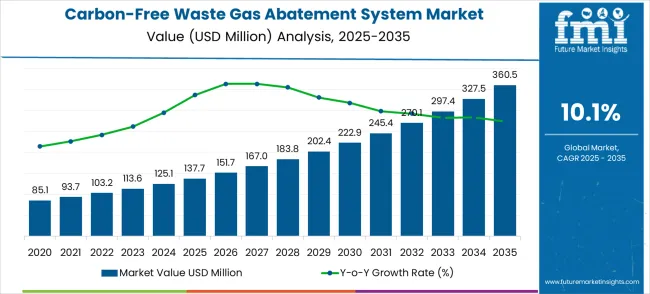
From 2026 to 2030, the market strengthens further, moving from USD 137.7 million to USD 202.4 million. This period reflects significant YoY growth, with values progressing through USD 151.7 million, 167.0 million, 183.8 million, and 202.4 million. The increased demand for carbon-free solutions to abate waste gases is fueled by stricter global emissions regulations, pushing industries to adopt advanced waste gas treatment systems. The innovations in abatement technologies, such as catalytic converters and scrubbers, contribute to the market’s accelerated growth. Between 2031 and 2035, the market reaches USD 360.5 million, advancing through USD 222.9 million, 245.4 million, 270.1 million, 297.4 million, and 327.5 million.
Between 2025 and 2030, the carbon-free waste gas abatement system market is projected to expand from USD 137.7 million to USD 230.2 million, resulting in a value increase of USD 92.5 million, which represents 41.5% of the total forecast growth for the decade. This phase of growth will be shaped by accelerating carbon neutrality commitments, increasing regulatory pressure for zero-emission processes, and growing adoption of sustainable manufacturing technologies. Environmental equipment manufacturers are expanding their carbon-free abatement portfolios to address the growing demand for zero-carbon emission systems with enhanced treatment efficiency and environmental compliance characteristics.
| Metric | Value |
|---|---|
| Estimated Value in (2025E) | USD 137.7 million |
| Forecast Value in (2035F) | USD 360.5 million |
| Forecast CAGR (2025 to 2035) | 10.1% |
The carbon-free waste gas abatement system market is closely tied to several parent markets. Within the air pollution control market, it holds a share of approximately 4-6%, driven by the increasing need for cleaner air solutions across industries such as manufacturing, energy, and chemicals. In the environmental technology market, it accounts for about 3-5%, as these systems play a crucial role in reducing emissions and improving industrial processes. The industrial emission control market captures around 5-7%, reflecting the heightened regulatory pressure on industries to minimize their environmental impact.
In the waste gas treatment market, carbon-free systems hold a notable share of 8-10%, as industries seek to meet stringent regulations for waste gas treatment. This segment has experienced strong growth due to the need for advanced technologies that can treat harmful gases effectively. The renewable energy and clean technology market also contributes to the expansion, with a market share of around 2-4%. These systems are increasingly integrated into industries focusing on cleaner production methods and energy generation.
From 2030 to 2035, the market is forecast to grow from USD 230.2 million to USD 360.5 million, adding another USD 130.3 million, which constitutes 58.5% of the overall ten-year expansion. This period is expected to be characterized by widespread implementation of net-zero manufacturing initiatives, integration with carbon capture and utilization technologies, and development of next-generation zero-emission abatement systems. The growing demand for sustainable semiconductor manufacturing and corporate carbon neutrality goals will drive adoption of sophisticated carbon-free abatement systems with enhanced environmental performance and energy efficiency characteristics.
Between 2020 and 2025, the carbon-free waste gas abatement system market experienced rapid development, driven by increasing corporate sustainability commitments and growing recognition of the need for zero-carbon industrial processes. The market evolved as manufacturers recognized the critical importance of eliminating carbon dioxide emissions from waste gas treatment systems to achieve comprehensive environmental sustainability goals. Breakthrough progress in advanced abatement technologies and carbon-free process design established the foundation for commercial deployment across various environmentally sensitive manufacturing applications.
Market expansion is being supported by the urgent need for carbon neutrality in industrial processes and the corresponding demand for abatement technologies that can achieve complete elimination of carbon dioxide emissions while maintaining treatment effectiveness. Modern semiconductor and electronics manufacturers are increasingly focused on environmental solutions that can support zero-carbon manufacturing goals while ensuring comprehensive waste gas treatment and regulatory compliance. The proven capability of carbon-free abatement systems to deliver effective treatment without generating carbon emissions makes them essential components of sustainable green manufacturing operations.
The growing emphasisfocus on corporate environmental responsibility and net-zero commitments is driving demand for advanced environmental technologies that can support comprehensive long-term viability sustainability objectives and carbon footprint reduction. Industry preference for treatment systems that can eliminate all forms of carbon emissions while providing reliable performance and operational efficiency is creating opportunities for innovative carbon-free abatement development. The rising influence of environmental, social, and governance (ESG) requirements and green manufacturing initiatives is also contributing to increased adoption of zero-carbon environmental technologies across different industrial sectors and applications.
The market is segmented by classification, application, and region. By classification, the market is divided into thermal abatement system, wet abatement system, thermal-wet abatement system, and others. Based on application, the market is categorized into semiconductor, photovoltaic, LED, and others. Regionally, the market is divided into Asia Pacific, North America, Europe, Latin America, and Middle East & Africa.
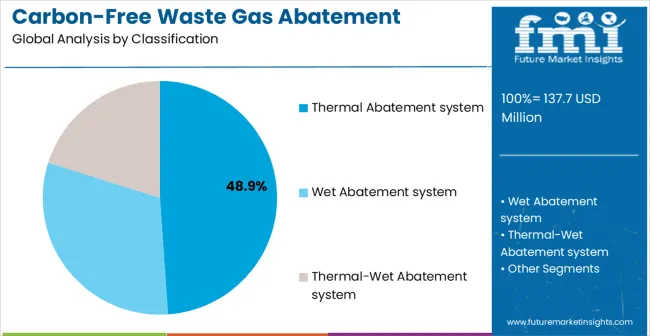
The thermal abatement system classification is projected to account for 48.9% of the carbon-free waste gas abatement system market in 2025, reaffirming its position as the category's dominant technology approach. Environmental engineers increasingly recognize the superior treatment efficiency and carbon-free operation capabilities provided by advanced thermal abatement systems for complex waste gas compositions. This classification addresses the most demanding treatment requirements while providing essential zero-carbon emission characteristics.
This classification forms the foundation of most carbon-free abatement installations, as it represents the most technically advanced and environmentally optimized approach for achieving complete waste gas destruction without carbon emissions. Technology development and process optimization continue to strengthen confidence in thermal abatement performance for carbon-free applications. With increasing recognition of the importance of zero-carbon environmental solutions, thermal systems align with both current eco-friendly sustainability requirements and long-term environmental objectives. Their comprehensive treatment capabilities across multiple gas types ensures sustained market dominance, making them the central growth driver of carbon-free abatement adoption.
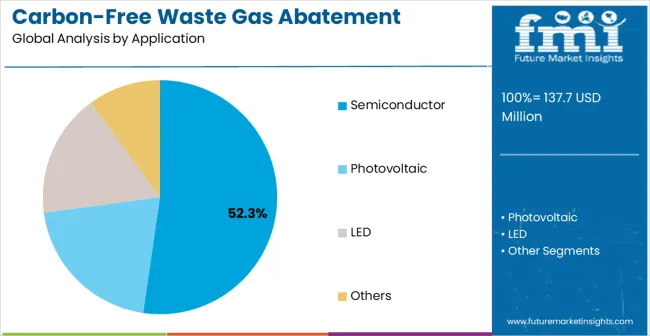
Semiconductor applications are projected to represent 52.3% of carbon-free waste gas abatement system demand in 2025, underscoring their role as the primary application driving market development. Semiconductor manufacturers recognize that fabrication processes require the most environmentally advanced and eco-friendlysustainable abatement technologies to achieve zero-carbon manufacturing goals while maintaining comprehensive emission control. Semiconductor applications demand exceptional environmental performance and resource efficiency sustainability that carbon-free abatement systems are uniquely positioned to deliver.
The segment is supported by the continuous expansion of green sustainable semiconductor manufacturing initiatives requiring comprehensive environmental solutions and the increasing adoption of corporate carbon neutrality commitments across the electronics industry. Additionally, semiconductor facilities are increasingly implementing advanced environmental technologies that can achieve zero-carbon operation while maintaining the highest treatment standards. As understanding of green sustainable manufacturing requirements advances, semiconductor applications will continue to serve as the primary commercial driver, reinforcing their essential position within the environmental technology market.
The carbon-free waste gas abatement system market is advancing rapidly due to increasing corporate eco-friendlysustainability commitments and growing demand for zero-carbon manufacturing processes. However, Tthe market faces challenges including higher capital investment requirements, complex technology integration, and limited availability of proven carbon-free solutions. Innovation in alternative treatment methods and energy optimization continue to influence product development and market expansion patterns.
The growing implementation of corporate sustainability programs is creating increased demand for carbon-free environmental technologies across global manufacturing operations. Advanced green sustainability frameworks require comprehensive zero-emission solutions, including carbon-free waste gas treatment, that are particularly important for achieving corporate environmental goals. Net-zero manufacturing initiatives provide opportunities for integrated environmental systems that can optimize both treatment performance and carbon footprint elimination.
Modern environmental equipment companies are incorporating non-combustion treatment methods, advanced catalytic processes, and energy recovery technologies to enhance carbon-free abatement performance while eliminating carbon dioxide generation. These technologies improve treatment efficiency, enable complete carbon elimination, and provide enhanced resource efficiency sustainability throughout system operation. Advanced integration also enables optimized energy utilization and improved overall environmental performance characteristics.
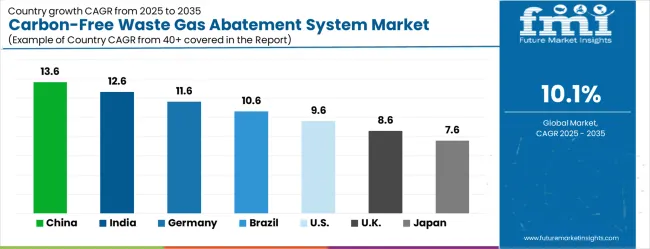
| Country | CAGR (2025-2035) |
|---|---|
| China | 13.6% |
| India | 12.6% |
| Germany | 11.6% |
| Brazil | 10.6% |
| USA | 9.6% |
| UK | 8.6% |
| Japan | 7.6% |
The carbon-free waste gas abatement system market is experiencing strong growth globally, with China leading at a 13.6% CAGR through 2035, driven by aggressive carbon neutrality commitments, comprehensive environmental regulations, and massive semiconductor manufacturing expansion requiring zero-carbon solutions. India follows at 12.6%, supported by growing environmental awareness, increasing electronics manufacturing capabilities, and rising adoption of sustainable green industrial technologies. Germany shows growth at 11.6%, emphasizing environmental technology leadership and comprehensive carbon reduction initiatives. Brazil records 10.6% growth, focusing on expanding green sustainable manufacturing practices and growing adoption of carbon-neutral technologies. The USA shows 9.6% growth, representing strong investment in clean technology development and sustainable eco-friendly manufacturing initiatives.
The report covers an in-depth analysis of 40+ countries; seven top-performing countries are highlighted below.
Revenue from carbon-free waste gas abatement systems in China is projected to exhibit extraordinary growth with a CAGR of 13.6% through 2035, driven by unprecedented carbon neutrality commitments and comprehensive government support for zero-carbon industrial technologies. The country's massive manufacturing base and aggressive environmental responsibility sustainability targets are creating tremendous opportunities for carbon-free abatement adoption. Major domestic and international environmental equipment companies are establishing comprehensive research and production facilities to serve the rapidly expanding eco-conscious sustainable manufacturing market.
Revenue from The carbon-free waste gas abatement systems market in India is expanding at a CAGR of 12.6%, supported by growing environmental awareness, increasing electronics manufacturing sector development, and rising investment in eco-friendly industrial technologies. The country's substantial manufacturing growth and commitment to environmental protection are driving demand for zero-carbon environmental solutions. International environmental equipment companies and domestic manufacturers are establishing partnerships to serve the growing demand for green manufacturing technologies.
carbon-free waste gas abatement systems in India is expanding at a CAGR of 12.6%, supported by growing environmental consciousness, increasing electronics manufacturing sector development, and rising investment in sustainable industrial technologies. The country's substantial manufacturing growth and commitment to environmental protection are driving demand for zero-carbon environmental solutions. International environmental equipment companies and domestic manufacturers are establishing partnerships to serve the growing demand for sustainable manufacturing technologies.
Revenue fromSales of carbon-free waste gas abatement systems in Germany is expanding projected to grow at a CAGR of 11.6%, supported by the country's leadership in environmental technology and comprehensive expertise in sustainable green manufacturing systems. German manufacturers and environmental equipment providers consistently invest in cutting-edge zero-carbon technologies and comprehensive eco-friendly sustainability solutions. The market is characterized by advanced engineering capabilities, comprehensive environmental frameworks, and established relationships between technology developers and industrial users.
Demand for Revenue from carbon-free waste gas abatement systems in Brazil is projected to growing at a CAGR of 10.6% through 2035, driven by expanding eco-conscious initiatives environmental sustainability initiatives, increasing adoption of clean manufacturing technologies, and growing focus on carbon-neutral industrial processes. Brazilian manufacturers are increasingly recognizing the importance of zero-carbon environmental solutions in achieving sustainability objectives and competitive positioning.
Revenue from cThe carbon-free waste gas abatement systems market in the USA is projected to grow expand at a CAGR of 9.6%, supported by substantial investment in clean technology development, established environmental innovation capabilities, and comprehensive corporate eco-responsibilitysustainability initiatives. American technology companies and manufacturers consistently advance carbon-free technologies through established research programs and sustainability green commitments.
Revenue fromDemand for carbon-free waste gas abatement systems in the UK is projected forecasted to grow expand at a CAGR of 8.6% through 2035, supported by comprehensive net-zero commitments and increasing investment in carbon-neutral industrial technologies. British manufacturers emphasize advanced environmental technologies within established eco-responsibility sustainability frameworks that prioritize carbon elimination and environmental stewardship.
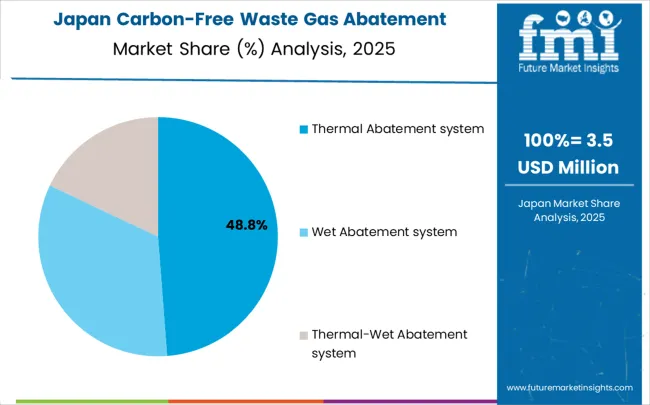
Revenue from The carbon-free waste gas abatement systems market in Japan is projected anticipated to grow at a CAGR of 7.6% through 2035, supported by the country's leadership in precision environmental engineering and comprehensive approach to sustainable green manufacturing technologies. Japanese manufacturers emphasize technology-driven development of sophisticated zero-carbon systems within established frameworks that prioritize technical excellence and environmental responsibility.
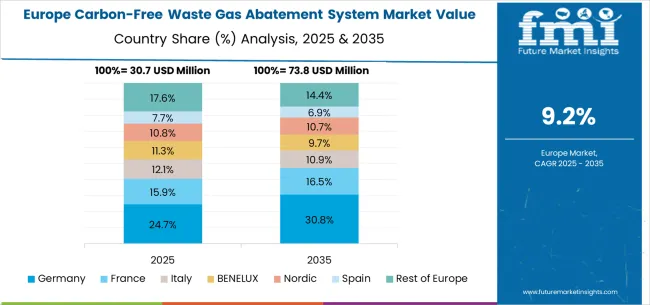
The carbon-free waste gas abatement system market in Europe is projected to expand rapidly through 2035, supported by comprehensive carbon neutrality commitments, established environmental regulations, and ongoing innovation in zero-carbon technologies. Germany will continue to lead the regional market, accounting for 32.1% in 2025 and rising to 33.4% by 2035, supported by strong environmental technology capabilities, advanced eco-friendly sustainable manufacturing infrastructure, and comprehensive carbon reduction frameworks. The United Kingdom follows with 19.8% in 2025, increasing to 20.2% by 2035, driven by net-zero commitment initiatives, government support for clean technology development, and expanding green sustainability requirements.
France holds 17.2% in 2025, edging up to 17.5% by 2035 as manufacturers expand carbon-neutral capabilities and demand grows for zero-carbon environmental technologies. Italy contributes 12.4% in 2025, remaining stable at 12.6% by 2035, supported by environmental resource-efficiency sustainability growth and increasing adoption of carbon-free systems. Spain represents 8.9% in 2025, moving upward to 9.1% by 2035, underpinned by expanding sustainable green manufacturing requirements and increasing investment in carbon-neutral technologies.
Nordic countries together account for 6.2% in 2025, maintaining their position at 6.3% by 2035, supported by advanced eco-responsibility sustainability initiatives and early adoption of innovative zero-carbon technologies. The Rest of Europe represents 3.4% in 2025, declining slightly to 0.9% by 2035, as larger markets capture greater investment focus and established environmental infrastructure advantages.
The carbon-free waste gas abatement system market is characterized by competition among specialized environmental technology companies, established industrial equipment manufacturers, and innovative clean technology developers. Companies are investing in advanced zero-carbon technologies, eco-friendly, sustainable process development, strategic partnerships, and application expertise to deliver high-performance, environmentally responsible, and cost-effective carbon-free abatement solutions. Technology development, green sustainability validation, and customer support strategies are central to strengthening competitive advantages and market presence.
Nippon Sanso leads the market with significant expertise in gas handling and environmental technologies, offering comprehensive carbon-free abatement solutions with focus on zero-emission performance and semiconductor applications. Ebara Technologies provides established environmental equipment capabilities with emphasisfocus on resource-efficient sustainable treatment systems and industrial process integration. Highvac Corporation focuses on specialized vacuum and environmental solutions with comprehensive carbon-free technology expertise. CSK (Atlas Copco) delivers advanced industrial technologies with strong focus on resource-efficient sustainable manufacturing and environmental performance.
DAS Environmental Expert operates with focus on specialized environmental solutions and comprehensive zero-carbon abatement systems for semiconductor and electronics manufacturing applications. These companies provide diverse technological approaches and eco-conscious sustainability expertise to enhance overall market development and environmental protection advancement across multiple industrial sectors.
| Items | Values |
|---|---|
| Quantitative Units (2025) | USD 137.7 mMillion |
| Classification | Thermal Abatement System, Wet Abatement System, Thermal-Wet Abatement System, Others |
| Application | Semiconductor, Photovoltaic, LED, Others |
| Regions Covered | Asia Pacific, North America, Europe, Latin America, Middle East & Africa |
| Countries Covered | China, India, Germany, Brazil, United States, United Kingdom, Japan and 40+ countries |
| Key Companies Profiled | Nippon Sanso, Ebara Technologies, Highvac Corporation, CSK (Atlas Copco), DAS Environmental Expert |
| Additional Attributes | Dollar sales by system type and application, regional sustainability adoption trends, competitive landscape, industrial partnerships, integration with carbon neutrality programs, innovations in zero-carbon treatment technologies, environmental performance analysis, and sustainability optimization strategies |
The global carbon-free waste gas abatement system market is estimated to be valued at USD 137.7 million in 2025.
The market size for the carbon-free waste gas abatement system market is projected to reach USD 360.5 million by 2035.
The carbon-free waste gas abatement system market is expected to grow at a 10.1% CAGR between 2025 and 2035.
The key product types in carbon-free waste gas abatement system market are thermal abatement system, wet abatement system and thermal-wet abatement system.
In terms of application, semiconductor segment to command 52.3% share in the carbon-free waste gas abatement system market in 2025.






Our Research Products

The "Full Research Suite" delivers actionable market intel, deep dives on markets or technologies, so clients act faster, cut risk, and unlock growth.

The Leaderboard benchmarks and ranks top vendors, classifying them as Established Leaders, Leading Challengers, or Disruptors & Challengers.

Locates where complements amplify value and substitutes erode it, forecasting net impact by horizon

We deliver granular, decision-grade intel: market sizing, 5-year forecasts, pricing, adoption, usage, revenue, and operational KPIs—plus competitor tracking, regulation, and value chains—across 60 countries broadly.

Spot the shifts before they hit your P&L. We track inflection points, adoption curves, pricing moves, and ecosystem plays to show where demand is heading, why it is changing, and what to do next across high-growth markets and disruptive tech

Real-time reads of user behavior. We track shifting priorities, perceptions of today’s and next-gen services, and provider experience, then pace how fast tech moves from trial to adoption, blending buyer, consumer, and channel inputs with social signals (#WhySwitch, #UX).

Partner with our analyst team to build a custom report designed around your business priorities. From analysing market trends to assessing competitors or crafting bespoke datasets, we tailor insights to your needs.
Supplier Intelligence
Discovery & Profiling
Capacity & Footprint
Performance & Risk
Compliance & Governance
Commercial Readiness
Who Supplies Whom
Scorecards & Shortlists
Playbooks & Docs
Category Intelligence
Definition & Scope
Demand & Use Cases
Cost Drivers
Market Structure
Supply Chain Map
Trade & Policy
Operating Norms
Deliverables
Buyer Intelligence
Account Basics
Spend & Scope
Procurement Model
Vendor Requirements
Terms & Policies
Entry Strategy
Pain Points & Triggers
Outputs
Pricing Analysis
Benchmarks
Trends
Should-Cost
Indexation
Landed Cost
Commercial Terms
Deliverables
Brand Analysis
Positioning & Value Prop
Share & Presence
Customer Evidence
Go-to-Market
Digital & Reputation
Compliance & Trust
KPIs & Gaps
Outputs
Full Research Suite comprises of:
Market outlook & trends analysis
Interviews & case studies
Strategic recommendations
Vendor profiles & capabilities analysis
5-year forecasts
8 regions and 60+ country-level data splits
Market segment data splits
12 months of continuous data updates
DELIVERED AS:
PDF EXCEL ONLINE
Waste Heat Power Generation Boiler Market Size and Share Forecast Outlook 2025 to 2035
Waste Wood Recycling Market Size and Share Forecast Outlook 2025 to 2035
Waste-derived Pyrolysis Oil Market Size and Share Forecast Outlook 2025 to 2035
Wastewater Heavy Metal Treatment Agent Market Size and Share Forecast Outlook 2025 to 2035
Waste Management Carbon Credit Market Size and Share Forecast Outlook 2025 to 2035
Waste Management Market Size and Share Forecast Outlook 2025 to 2035
Wastewater Treatment Aerators Market Size and Share Forecast Outlook 2025 to 2035
Waste Heat To Power Market Size and Share Forecast Outlook 2025 to 2035
Waste to Energy Market Growth - Trends & Forecast 2025 to 2035
Waste Recycling Services Market by Application, Product Type, and Region - Growth, Trends, and Forecast 2025 to 2035
Waste Wrap Film Market
E-Waste Management Market Growth - Trends & Forecast 2025 to 2035
AI Waste Sorting Robots Market Forecast and Outlook 2025 to 2035
Oily Waste Can Market Size and Share Forecast Outlook 2025 to 2035
Zero-Waste Packaging Technologies Market Size and Share Forecast Outlook 2025 to 2035
Zero-Waste Refill Packaging Market Analysis - Size, Share, and Forecast Outlook 2025 to 2035
Food Waste Shredder Market Size and Share Forecast Outlook 2025 to 2035
Food Waste Disposal Equipment Market Size and Share Forecast Outlook 2025 to 2035
Food Waste Composting Machine Market Size and Share Forecast Outlook 2025 to 2035
Food Waste-Derived Protein Market Size and Share Forecast Outlook 2025 to 2035

Thank you!
You will receive an email from our Business Development Manager. Please be sure to check your SPAM/JUNK folder too.
Chat With
MaRIA